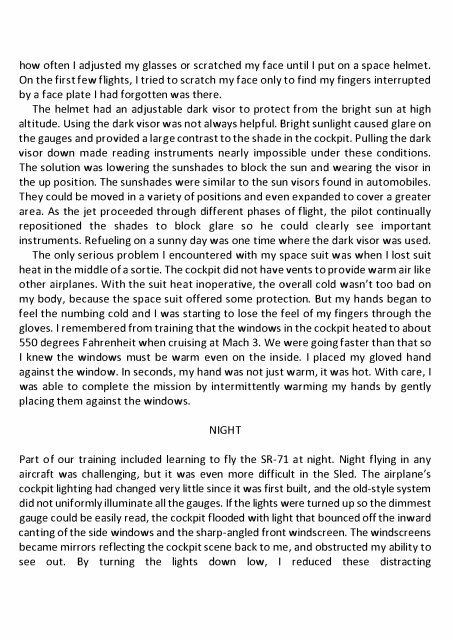You also want an ePaper? Increase the reach of your titles
YUMPU automatically turns print PDFs into web optimized ePapers that Google loves.
how often I adjusted my glasses or scratched my face until I put on a space helmet.<br />
On the first few flights, I tried to scratch my face only to find my fingers interrupted<br />
by a face plate I had forgotten was there.<br />
The helmet had an adjustable dark visor to protect from the bright sun at high<br />
altitude. Using the dark visor was not always helpful. Bright sunlight caused glare on<br />
the gauges and provided a large contrast to the shade in the cockpit. Pulling the dark<br />
visor down made reading instruments nearly impossible under these conditions.<br />
The solution was lowering the sunshades to block the sun and wearing the visor in<br />
the up position. The sunshades were similar to the sun visors found in automobiles.<br />
They could be moved in a variety of positions and even expanded to cover a greater<br />
area. As the jet proceeded through different phases of flight, the pilot continually<br />
repositioned the shades to block glare so he could clearly see important<br />
instruments. Refueling on a sunny day was one time where the dark visor was used.<br />
The only serious problem I encountered with my space suit was when I lost suit<br />
heat in the middle of a sortie. The cockpit did not have vents to provide warm air like<br />
other airplanes. With the suit heat inoperative, the overall cold wasn't too bad on<br />
my body, because the space suit offered some protection. But my hands began to<br />
feel the numbing cold and I was starting to lose the feel of my fingers through the<br />
gloves. I remembered from training that the windows in the cockpit heated to about<br />
550 degrees Fahrenheit when cruising at Mach 3. We were going faster than that so<br />
I knew the windows must be warm even on the inside. I placed my gloved hand<br />
against the window. In seconds, my hand was not just warm, it was hot. With care, I<br />
was able to complete the mission by intermittently warming my hands by gently<br />
placing them against the windows.<br />
NIGHT<br />
Part of our training included learning to fly the SR-71 at night. Night flying in any<br />
aircraft was challenging, but it was even more difficult in the <strong>Sled</strong>. The airplane's<br />
cockpit lighting had changed very little since it was first built, and the old-style system<br />
did not uniformly illuminate all the gauges. If the lights were turned up so the dimmest<br />
gauge could be easily read, the cockpit flooded with light that bounced off the inward<br />
canting of the side windows and the sharp-angled front windscreen. The windscreens<br />
became mirrors reflecting the cockpit scene back to me, and obstructed my ability to<br />
see out. By turning the lights down low, I reduced these distracting


